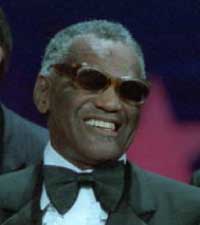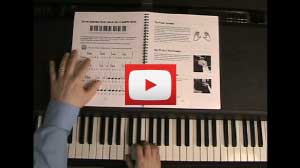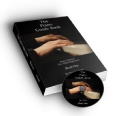Jump Blues Pianists:
Charles Brown, Amos Milburn, Jay McShann, Floyd Dixon, Buddy Johnson, Lloyd Glenn, Ray Charles
The era for jump blues pianists started in the early 1940's and lasted into the early 50's. Though some of the following pianists might not be called "jump blues" piano players, all of them made their mark during this period.
Jump blues is the link between swing and blues of the 1950's. In reaction to the war and post-war economy, jump blues was performed by smaller bands with a smaller horn section, plus piano, bass, drums, and and the first widespread use of the electric guitar. Jump blues pianists of this era include Jay McShann, Floyd Dixon, Amos Milburn and Lloyd Glenn.
During this era a smooth blues evolved in Los Angeles, built around a trio of piano, bass and guitar. Charles Brown, Buddy Johnson and Ray Charles exemplify this sound.
Lloyd Glenn, 1909-1985
Lloyd Glenn was born in San Antonio Texas, and was performing jazz around San Antonio and Dallas during the 1920's and '30's. He made his first recordings in 1936 with the Don Albert Orchestra, but left the band and moved to Los Angeles in 1941.
By 1944 Lloyd was established as a first call jump blues pianist session musician, and performed on one of the biggest selling blues records of all time, T Bone Walker's "Stormy Monday Blues." He had some jump blues dance hits with his band Lloyd Glenn and His Joymakers. He became an A&R talent scout for Swing Time, signing and playing on Lowell Fulson's records.
In 1950, Lloyd had some jump blues hits including "Old Time Shuffle Blues," which hit #3, and in '51, had a #1 hit with "Chica Boo." During this period he also played in Kid Ory's New Orleans jazz revival band.
He left Swing Time Records to join with Alladin Records in 1953, played on numerous sessions and occasional tours. During the '60's he played on B. B. King records including My Kind of Blues and most notably Lucille. Lloyd Glenn died from a heart attack in 1985.
Buddy Johnson, 1915-1977
Buddy Johnson was born Woodrow Wilson Johnson in Darlington, South Carolina. As a young boy he took classical piano lessons. In 1938 he moved to New York City and landed a gig with The Cotton Club Revue. The Revue toured Europe in 1939, where Buddy was expelled from Germany for playing boogie woogie music.
Upon returning from Europe, he was signed to Decca Records. In 1941 he assembled a nine piece band, producing a string of jump blues hits during the 1940's. In 1946 he composed a "blues concerto," which was performed at Carnegie Hall in 1948. He continued playing as a jump blues pianist through the 1950's, recording for Mercury Records.
He may be best known for his songwriting. His "Save Your Love For Me" and "Since I Fell For You" have become jazz/blues standards. "Since I Fell For You" was a huge hit for singer Lenny Welch in the early '60's.
Buddy Johnson died from a brain tumor in 1977.
Jay McShann, 1916-2006
Jay McShann was born in Muskogee, Oklahoma. At a youg age he heard Earl "Fatha" Hines on the radio and began playing jazz and boogie woogie.
In 1931 he started playing professionally, and moved to Kansas City in 1936. In the '30's, Kansas City had hundreds of places for a jump blues pianist to play and soon McShann was a top band leader in that city. He put together a big band in 1937 that played jazz, swing and blues, but recorded mostly blues numbers. Some notable members of that band include Charlie Parker and Ben Webster.
McShann was drafted into the army in 1944, and after the war he put together smaller jump blues bands. He had a hit in 1949 with Jimmy Witherspoon singing "Ain't Nobody's Business." Though he continued to work, his popularity faded during the 1950's. He performed occasionally into his 80's.
Charles Brown, 1922-1999

Charles Brown was born in Texas City, Texas, a town near Houston. He learned classical piano as a child and was an excellent student in math and chemistry. His parents frowned upon his musical pursuits, so he went to college, getting a degree in chemistry, and later a job as a teacher.
Music was his calling, though. In 1944 he was playing in Los Angeles in Johnny Moore's Three Blazers, one of the top bands in the L.A. club scene which catered to the vast numbers of returning servicemen. They signed a contract with Alladin Records to release "Drifting Blues," which featured Brown's relaxed and smooth vocal style. This huge hit led to many more including "Black Night," "Hard Times," and "Trouble Blues."
Brown's smooth style couldn't compete with rowdy rock'n'roll, and his star began to fade in the later '50's. He did have two Christmas hits with "Merry Christmas Baby" in 1956 and "Please Come Home For Christmas" in '60. He released occasional records through the '60's and '70's on various blues labels.
In the early 1980's singer Bonnie Raitt helped Brown stage a comeback which included tours and recordings for Rounder Records. Charles Brown continued touring until his death in 1999.
Amos Milburn, 1927-1980
Amos Milburn, from Houston Texas, was one of 13 children. He began playing piano at age 5, taking lessons in the classics. At age 15 Amos joined the Navy, and earned medals for bravery during battles in the Phillipines.
After the war Milburn returned to Houston and formed a 16 piece band that played swing and blues in the Houston clubs. In 1946 Amos was signed to Alladin Records, recording more than 75 songs over the next 8 years. Some of the sides include "Down The Road A Piece," "Rockin'," and "Chicken Shack." He moved to Los Angeles in 1950, and continued making hits, including "One Scotch, One Bourbon, One Beer" and "Bad, Bad Whiskey." Though not known as a drinker, he became known for drinking songs.
He toured the U.S. in the early '50's. In the late '50's, Amos moved back to Houston, recording occasionally. In 1962 he made an album for Motown Records that included "Little" Stevie Wonder on Harmonica. He recorded his last session in 1972 with Johnny Otis.
Amos Milburn was one of the jump blues pianists that defined the genre. He was a major influence on Ray Charles and Fats Domino, mixing the rocking with the rolling before rock and roll. Amos Milburn died in 1980 from a stroke.
Floyd Dixon, 1929-2006
Floyd Dixon is another of the jump blues pianists to hail from Texas. He was born Jay Riggins Jr. in the town of Marshall. He learned to play jazz, blues, country and gospel. His family moved to Los Angeles when he was 13, where he met and idolized Charles Brown.
Dixon was signed to Modern Records in L.A. in 1949, and had a string of jump blues drinking hits including "Wine, Wine, Wine," which has become a blues standard. He moved to Specialty Records in 1952, releasing "Hey Bartender," which was later covered by the Blues Brothers. He retired in the ealy 1970's, only occasionally touring. In 1984 Floyd was commissioned to compose "Olympic Blues" for the Los Angeles Summer Olympics.
In 1993 Dixon received the Pioneer Award from the Rhythm and Blues Foundation, and released a CD on Alligator Records. He died at age 77 from kidney failure.
Ray Charles, 1930-2004

Ray Charles Robinson, born in Albany Georgia, originally made his mark on the music charts as one of the jump blues pianists, but grew in stature to become an American music icon, inventing "soul" music, recreating country music and popular standards to fit his vision.
Ray lost his sight at age 6, and went to the Florida School for the Blind and Deaf. Between 1937 and 1945 he studied music, learning to read and write in Braille. He studied the classics, but also played whatever he heard on the radio, including boogie woogie, blues, jazz and country.
He moved to Seattle in 1947, wanting to try city life, but not feeling ready for New York or L.A. By 1949 Ray had signed with Swing Time Records, first making Charles Brown sound-alike records. He had a #2 R&B hit with "Confessin' The Blues." In 1951 he had a #5 hit with "Baby Let Me Hold Your Hand."
Atlantic Records bought his contract in 1952, where he made more rockin' jump blues records. His first hit for Atlantic was "It Should've Been Me." Atlantic boss Ahmet Ertegun wrote "Mess Around"('53) for Ray, borrowing a riff from Cow Cow Davenport. More jump blues hits followed, including "This Little Girl Of Mine," "Lonely Avenue," plus some with more of a gospel tinge like "The Nighttime Is The Right Time," and "Hallelujah, I Love Her So."
In 1959, Ray broke into the Top 40 with "What I'd Say," playing a Wurlitzer electric piano. This song made Ray a superstar who now toured the world.
Ray left Atlantic Records, signing an unprecedented autonomous deal with ABC in 1959. He had a string of Top 40 hits in the early '60's including "Georgia On My Mind"(#1) "Hit The Road, Jack" (#1), and "Unchain My Heart" (#9). He shook the music world with his album Modern Sounds in Country and Western Music in 1963. Hits included "Busted" and "Here We Go Again." In 1965 he was busted, (arrested) for heroin possesion, and spent time in a recovery clinic.
He continued recording at his own studio in L.A. through the '70's and '80's. In 1980 Ray appeared in the smash hit movie The Blues Brothers, playing a pawn shop owner. His "Right One Baby" ad campaign for Pepsi created a whole new audience for his music in the mid and late 1980's.
Ray Charles has had a profound effect on American music. He was much more than just a jump blues pianist. He changed popular music with his heartfelt vocal style, his mixing of blues and gospel to make "soul" music, and his crossover into Country and Western music. Ray Charles was recording and performing right up until his death in 2004.
Charles Brown Photo: Sumari, Creative Commons Lic.Creative Commons
Start Playing Piano Today with the Piano Guide Quick Start Course!
Easy to follow step-by-step lessons designed for adult beginners. The next best thing to private lessons!
What You'll Learn:
- Notes on the piano/keyboard
- Proper fingering
- C major scale
- Chords
- How to read music
- And much more!

Video lessons - watch as I play everything for you.

